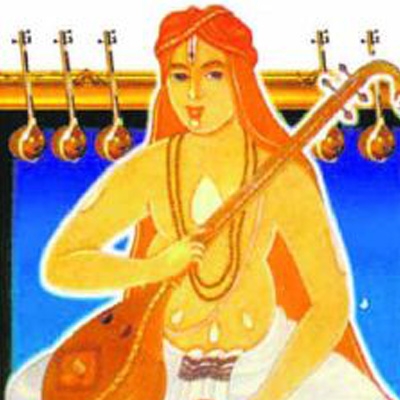
Named Srinivasa after the lord of the seven hills, in Purandaragad, a village near Hampi, the saint-composer was the only son of Varadappa Naik, a wealthy merchant. He received a good education in accordance with family tradition and acquired proficiency in Kannada, Sanskrit, sacred lore, and music. When he was sixteen, he married Saraswatibai, a pious girl. Losing his parents when he was 20, he inherited his father's business in precious stones and pawn-broking, and in a short time, expanded it and amassed immense wealth, to soon be known as Navakoti Narayana.
When he was at the zenith of his business, Providence enacted the now-famous nose-ring episode, to make the greedy and miserly merchant realise the worthlessness of his attachment to worldly possessions. The shock treatment marked a turning point in his life. Giving away all his wealth to charity, he left his house with his wife and children to lead the life of a wandering minstrel to spread the gospel of God. He was only 30.
In his very first song after the incident, he laments his wasted life of indulgence.
In the course of his wandering he met the sage Vyasaraya.
According to Prof. Sambamoorthy, Srinivasa had his formal initiation at the hands of Vyasaraya in 1525 when Vyaysraya was about 40. The name Purandaradasa is believed to have been bestowed on him by Satyadharma Teertha, a later occupant of the Vyasaraya Mutt.
Purandaradasa travelled extensively through the Vijayanagara empire, composing and rendering soul-stirring songs in praise of God. He spent his last years in Hampi, staying at what is now known as the Purandaradasa Mandapa. He became a renunciate towards the end of his life. He died in 1564.
Purandaradasa was a prolific composer of keertanas that have come to be known as padas and devarnamas. Legend has it that he composed 475,000 songs, though only 600 have survived. His songs touch every aspect of life—including devotion, morality, ethics, good behaviour and compassion to all living beings. Barring a few, all his compositions are in simple Kannada, the language of the masses.
The credit for writing down the notation for about 200 of Purandaradasa’s songs goes to Mysore Karigiri Rao (1853-1927). He was a musician in the court of Chamaraja Wodeyar IX of Mysore (1881-1894). A noted composer in his own right, he was the guru of Bidaram Krishnappa and Rallepalli Ananthakrishna Sarma. Karigiri Rao is said to have visited several villages to find the tunes in which the Haridasas and the villagers had rendered them for generations. He then notated the songs to the tunes he heard. Thus, Karigiri Rao's notations are believed to be authentic.
Purandaradasa systematised the teaching method in Carnatic music by framing a series of graded lessons such as swaravalis, janta swaras, alankaras, lakshana geetas, prabandhas, ugabhogas and sooladis. A student can gain mastery over swaraprastara and talaprastara by a systematic study and practice of these lessons. He introduced Mayamalavagaula as the basic scale for music instruction.
He also composed a large number of lakshya and lakshana geetas. His sooladis reveal his extraordinary mastery of the techniques of music, and are considered the last word on raga lakshana. Scholars attribute the standardisation of varna mettus entirely to Purandaradasa. Thus, Purandaradasa was a vaggeyakara, lakshanakara and the father of musical pedagogy.


